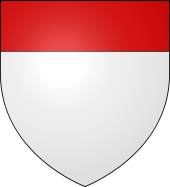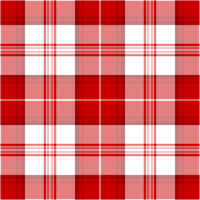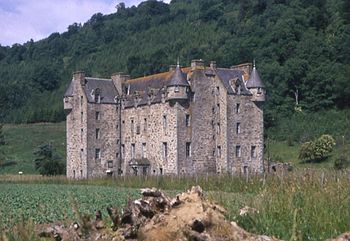- Clan Menzies
-
Clan Menzies Crest badge 
Crest: A savage head erased Proper Motto: VIL GOD I SAL War cry: Geal 'us Dearg a suas.[1] Profile Region Highland District Perthshire Plant badge The Menzies' Heath.[2] Pipe music Piobairreachd a' Mheinnearaich.[3] Gaelic name Clann Mèinnear Chief

David Ronald Steuart Menzies of Menzies,[4] The Menzies, Representer of the House and Family of Menzies of that Ilk, Head of the Clan Menzies.[5] Gaelic title Am Meinnearach.[6] Historic seat Castle Menzies  A romantic depiction of a clansman illustrated by R. R. McIan, from James Logan's The Clans of the Scottish Highlands, 1845.
A romantic depiction of a clansman illustrated by R. R. McIan, from James Logan's The Clans of the Scottish Highlands, 1845.
For Menzies as a personal name, including its pronunciation and a list of famous people of that name, see Menzies.
Clan Menzies (
 listen (help·info)); Scottish Gaelic: Clann Mèinnear, a member is a Mèinnearach) is a Highland Scottish clan.
listen (help·info)); Scottish Gaelic: Clann Mèinnear, a member is a Mèinnearach) is a Highland Scottish clan.Contents
History
Origins of the Clan
Mesnières in Normandy was the original home of the Norman family whose name was transformed to Manners, which was the surname of the Dukes of Rutland. A branch of this family moved into Lothian in Scotland and gradually into the Scottish Highlands, where they first became known by the name Meyneris and eventually as Menzies.
It is believed that the Menzies were granted lands in Lothian in the 12th Century, almost certainly in exchange for military service.
The first Chief of Menzies was Sir Robert de Meyneris who became Chamberlain to King Alexander II of Scotland in 1249. The Menzies clan also became allies with the Earl of Atholl and Clan Murray. Sir Robert de Meyneris son, called Alexander, was granted lands and property in Strathtay. He was later also granted lands in and property in Weem. However the Castle Weem was built there two centuries later
Wars of Scottish Independence
In the 14th century during the Wars of Scottish Independence Clan Menzies supported Robert the Bruce at the Battle of Bannockburn. The Clan Menzies achieved further success by supporting Robert the Bruce right up to his death by which time their lands stretched from Aberfeldy almost as far as Loch Lomond.
16th Century
Weem was plundered in 1502 by Stewart of Garth during a dispute over the ownership of lands in Fothergill. Janet Menzies had married a Stewart about a century earlier, and Garth claimed the lands as part of her tocher, or dowry. Menzies appealed to the Crown, and James IV found in his favour, ordered Stewart to make restitution, and erected the Menzies lands into the free barony of Menzies in 1510. In 1540 James Menzies of Menzies married Barbara Stewart, daughter of the third Stewart Earl of Atholl and cousin to Lord Darnley, the future King Henry.
In the sixteenth century, King James IV of Scotland granted a charter converting the Menzies' lands into a barony. By now the clan was Gaelic speaking and the chief became known as "Am Mainnearach" meaning "The Menzies".
17th Century & Civil War
During the English/Scottish Civil War the main part of the Menzies from Weems joined forces with Clan Campbell in support of the Scottish Argyll government. Despite both their Stewart and royal links, the Menzies chiefs opposed Charles I, and the Clan Menzies was harried by James Graham, 1st Marquess of Montrose. The great marquess sent a messenger to him seeking to enlist support but, whether by accident or design, the envoy was wounded. Montrose retaliated, and in the skirmishing which ensued the Menzies chief was fatally wounded. His son, a major in the Army of the Covenant, was killed when Montrose caught Argyll unprepared at the Battle of Inverlochy (1645).
However the Pitfoddels branch of Menzies supported the Royalist Marquis of Montrose. The Menzies of Pitfoddels carried the Royal Standard at the Battle of Invercarron in 1650, fighting in support of James Graham, 1st Marquess of Montrose.
By 1651 the Scottish Covenanter Government had become disillusioned with the English parliament and decided to join the royalists instead. At the Battle of Worcester a brother of Chief Alexander Menzies died fighting as a royalist.
In 1665, Sir Alexander Menzies was created a Baronet of Nova Scotia. His brother, Colonel James Menzies of Culdares, ancestor of the present chief, was a veteran of the civil war who, it was claimed, had survived no less than nine serious wounds.
Major Duncan Menzies of Fornock led the charge which broke the line of the government troops at the Battle of Killiecrankie in 1689 (though there were also many Menzies on the opposing side).
18th Century & Jacobite Uprisings
During the Jacobite rebellions the main part of Clan Menzies remained neutral. However branches of the clan such as Menzies of Shian and Menzies of Pitfodel fought in battles on the side of the Jacobites.
At the end of the eighteenth century, the Menzies name gained momentary prominence when James Menzies, a merchant in Weem, was one of the leaders of a protest by thousands of men and women against the Militia Ballot Act, passed in fear of a French invasion in the wake of the Revolution of 1789. The Act compelled all men between the ages of nineteen and twenty-three to submit to a ballot as recruits for the army. Menzies and his citizen army forced Sir John Menzies and the Duke of Atholl to swear that they would not implement the Act, and even tried to arm themselves with weapons from the Campbell castle at Taymouth. But they were no match for regular troops, scattering at the first sign of serious opposition.
Clan Chief
The current chief of Clan Menzies is David R.S. Menzies of Menzies.
Castle Menzies
Castle Menzies in Scotland is home of the Menzies Clan. It is located in the small village of Weem, near Aberfeldy in the Highlands.
The sixteenth century castle, restored by the Menzies Clan Society, has been the seat of the Chiefs of Clan Menzies for over 400 years. It was strategically situated, and it was involved in the turbulent history of the Highlands. Bonnie Prince Charlie, the Stuart Pretender to the throne, rested for two nights in the castle on his way to the Battle of Culloden in 1746, where the Jacobite clans were essentially broken by a British army equipped with cannons.
The restored castle is architecturally fascinating, a splendid example of the transition between earlier rugged fortress and later mansion house. It served as a hospital for the Polish army in exile during World War II.
Clan Septs
Spelling variations, names associated with the clan and septs of the Clan Menzies include:
Dewar, Deware, Dewere, Jore, MacAndeoir, MacIndeoir, MacIndeor, MacIndoer, MacJore, MacKmunish, MacMean, MacMeans, MacMein, MacMeinn, MacMen, MacMenzies, MacMin, MacMina, MacMine, MacMinn, MacMinne, MacMinnies, MacMinnis, MacMonies, MacMonnies, MacMyn, MacMyne, MacMynneis, McMenzies, McMenzie, Mainzies, Makmunish, Makmynnes, Manzie, Manzies, Maynhers, Mean, Meanie, Meanies, Means, Megnies, Meignees, Meigneis, Meigners, Meignerys, Meignes, Meignez, Mein, Meine, Meineris, Meingnes, Meingzeis, Meingzes, Meinn, Meinyeis, Meinyies, Meinzeis, Meinzies, Menees, Mengues, Mengyeis, Mengzeis, Mengzes, Mengzies, Mennes, Mennie, Menyas, Menyeis, Menyheis, Menyhes, Menzas, Menzeis, Menzes, Menzeys, Menzheis, Menzhers, Menzies, Menzis, Meygners, Meygnes, Meyneiss, Meyner, Meyneris, Meyners, Meyness, Miners, Minn, Minnis, Minnish, Minnus, Monsie, Monzie, Munnies.
References
- ^ The Scottish clans andtheir tartans : with notes, pp.10, 1900 Edinburgh : W. & A.K. Johnston
- ^ The Scottish clans andtheir tartans : with notes, pp.10, 1900 Edinburgh : W. & A.K. Johnston
- ^ The Scottish clans andtheir tartans : with notes, pp.166, 1900 Edinburgh : W. & A.K. Johnston
- ^ burkespeerage.com
- ^ burkespeerage.com
- ^ burkespeerage.com
External links
Scottish clans Clans with chiefs Agnew · Anstruther · Arbuthnott · Arthur · Bannerman · Barclay · Borthwick · Boyd · Boyle · Brodie · Broun · Bruce · Buchan · Burnett · Cameron · Campbell · Carmichael · Carnegie · Cathcart · Charteris · Chattan · Chisholm · Cochrane · Colquhoun · Colville · Cranstoun · Crichton · Cumming · Darroch · Davidson · Dewar · Drummond · Dunbar · Dundas · Durie · Elliot · Elphinstone · Erskine · Farquharson · Fergusson · Forbes · Forsyth · Fraser · Fraser of Lovat · Gayre · Gordon · Graham · Grant · Gregor · Grierson · Guthrie · Haig · Haldane · Hamilton · Hannay · Hay · Henderson · Home · Hope · Hunter · Irvine · Jardine · Johnstone · Keith · Kennedy · Kerr · Kincaid · Lamont · Leask · Lennox · Leslie · Lindsay · Lockhart · Lumsden · Lyon · MacAlister · MacBain · MacDonald · Macdonald of Clanranald · MacDonald of Keppoch · Macdonald of Sleat · MacDonell of Glengarry · MacDougall · Macdowall · MacIntyre · Mackay · Mackenzie · Mackinnon · Mackintosh · Maclachlan · Maclaine of Lochbuie · MacLaren · MacLea (Livingstone) · Maclean · MacLennan · MacLeod · MacLeod of Lewis · MacMillan · Macnab · Macnaghten · MacNeacail · MacNeil · Macpherson · MacTavish · MacThomas · Maitland · Makgill · Malcolm (MacCallum) · Mar · Marjoribanks · Matheson · Menzies · Moffat · Moncreiffe · Montgomery · Morrison · Munro · Murray · Napier · Nesbitt · Nicolson · Ogilvy · Oliphant · Primrose · Ramsay · Rattray · Riddell · Robertson · Rollo · Rose · Ross · Ruthven · Sandilands · Scott · Scrymgeour · Sempill · Shaw · Sinclair · Skene · Spens · Stirling · Strange · Stuart of Bute · Sutherland · Swinton · Trotter · Urquhart · Wallace · Wedderburn · Wemyss · Wood ·
Armigerous clans Abercromby · Abernethy · Adair · Adam · Aikenhead · Ainslie · Aiton · Allardice · Anderson · Armstrong · Arnott · Auchinleck · Baillie · Baird · Balfour · Bannatyne · Baxter · Bell · Belshes · Bethune · Beveridge · Binning · Bissett · Blackadder · Blackstock · Blair · Blane · Blyth · Boswell · Brisbane · Buchanan · Butter · Byres · Cairns · Calder · Caldwell · Callender · Campbell of Breadalbane · Campbell of Cawdor · Carruthers · Cheyne · Chalmers · Clelland · Clephane · Cockburn · Congilton · Craig · Crawford · Crosbie · Cunningham · Dalmahoy · Dalrymple · Dalzell · Dennistoun · Don · Douglas · Duncan · Dunlop · Edmonstone · Fairlie · Falconer · Fenton · Fleming · Fletcher · Forrester · Fotheringham · Fullarton · Galbraith · Galloway · Gardyne · Gartshore · Ged · Gibsone · Gladstains · Glas · Glen · Glendinning · Gray · Gunn · Haliburton · Halkerston · Halket · Hepburn · Heron · Herries · Hogg · Hopkirk · Horsburgh · Houston · Hutton · Inglis · Innes · Kelly · Kinloch · Kinnaird · Kinnear · Kinninmont · Kirkcaldy · Kirkpatrick · Laing · Lammie · Langlands · Learmonth · Little · Logan · Logie · Lundin · Lyle · MacAulay · Macbrayne · MacDuff · MacEwen · MacFarlane · Macfie · Macgillivray · MacInnes · MacIver · Mackie · MacLellan · Macquarrie · Macqueen · Macrae · Masterton · Maule · Maxton · Maxwell · McCorquodale · McCulloch · McKerrell · Meldrum · Melville · Mercer · Middleton · Moncur · Monteith · Monypenny · Mouat · Moubray · Mow · Muir · Murray of Atholl · Nairn · Nevoy · Newlands · Newton · Norvel · Ochterlony · Orrock · Paisley · Paterson · Pennycook · Pentland · Peter · Pitblado · Pitcairn · Pollock · Polwarth · Porterfield · Preston · Pringle · Purves · Rait · Ralston · Renton · Roberton · Rossie · Russell · Rutherford · Schaw · Seton · Skirving · Somerville · Spalding · Spottiswood · Stewart · Stewart of Appin · Strachan · Straiton · Strange · Sydserf · Symmers · Tailyour · Tait · Tennant · Troup · Turnbull · Tweedie · Udny · Vans · Walkinshaw · Wardlaw · Watson · Wauchope · Weir · Whitefoord · Whitelaw · Wishart · Young
Culture and society Scotland · Clan chief · Septs · Clan badge · Clan crest · Clan battles · Tartan · Bagpipes · Clearances · Kilt · Manrent · The Highlands · Battle of Culloden · Highland games · Border Reivers · Scottish heraldry · Scottish surnames
Categories:- Scottish clans
- Scoto-Norman clans
Wikimedia Foundation. 2010.


